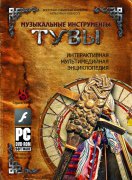 Festina lente or make haste slowly is what scientists know and believe in, as sometimes there is a huge time gap between the emergence of an idea and its actual implementation. In our case, the project of the electronic encyclopedia “Musical Instruments of Tuva” has appeared six years later after the first thought of it.
Festina lente or make haste slowly is what scientists know and believe in, as sometimes there is a huge time gap between the emergence of an idea and its actual implementation. In our case, the project of the electronic encyclopedia “Musical Instruments of Tuva” has appeared six years later after the first thought of it.
The Encyclopedia released last year under the aegis of the East-Siberian State Academy of Culture and Arts is popular among students, musicians, scientists, and curious readers. The project has received a huge number of positive responses from the leading folk bands of the region, throat singers, scientists, journalists, and numerous foreign guests of the republic.
Such high rating was especially pleasant for the authors of the project – the Candidacy of Pedagogical Sciences, the Dean of Tuvan branch of the East-Siberian State Academy of Culture and Arts Vera Koshkar-ool and Doctor of Culturology Valentina Suzukei, who is working in Tuvan Institute of Humanitarian Researches for many years.
Although, it is the first project dedicated to Tuvan folk music in the Inner Asia, the electronic Encyclopedia has become an example to follow, and to the large extent due to the best Tuvan folk bands such as Khun Hur Tuu, Chirgilchin, Alash, Tyva Kyzy working on it. A photo expert Vasiliy Balchiy- ool, a cameraman Alexander Yenzak and a journalist Andrey Chymba were shaping the encyclopedia by adding images, videos and sounds. Some of the art works of Vera Sagaan were also used in the project.
The Encyclopedia gives very useful information about all the diversity of Tuvan traditional folk instruments from ones accompanying lyrical songs, heroic epos, reproducing hunting sound imitations, or used in shaman rituals and ceremonies. Once the information about Tuvan musical instruments is systematized it is much easier to realize how culturally rich Tuvan people are. Many thanks to Valentina Suzukey for the huge research have been made throughout this time.
Each musical item is clickable with available pictures, soundings, and general information in Russian and English. The main importance of the project is that musical ancestry is not just a museum rarity, but is presented by existing instruments, which are relatively popular, and its’ music is loved by thousands of people. Anyone can learn playing them and get the first lessons from videos on the disk.
The wide part of the project is dedicated to quite exclusive information about the makers of Tuvan instruments. Such bands as Yat-kha, Khun-Hur-Tuu, Chirgilchin, Alash and their music demonstrate how Tuvan folk is contemporary and entertaining.

